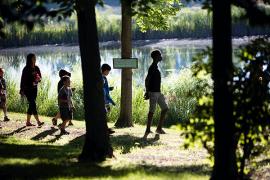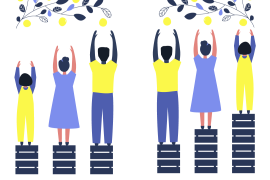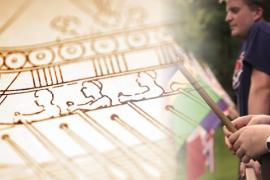You pick up the phone, dial Ms. Sunny’s cell number, and wait for it to ring. You know that the call pops up on Ms. Sunny’s cell phone screen as “Camp ALotofFun” (“Camp ALF”) — and that her heart drops when she sees the call. Your heart skips a beat as Ms. Sunny answers: “Hi! OMG. Is Ethan OK?”
You very quickly and kindly say, “Ms. Sunny, it’s Jane from Camp ALF. Your son is safe and everything is OK.” Then, cautiously and in a serious tone, you let her know the reason for the call. A counselor and her son have argued about washing his hair. And within that argument, he made a comment about how his hair is different from the counselor’s. Her son is White, and the counselor is Black — an important fact.
For generations, a camp director’s focus on safety meant protecting campers from physical harm. In today’s reality that is still a necessity though insufficient. Safe space at camp has now evolved beyond mere physical safety.
Jane was calling to highlight her commitment to creating a safe environment at Camp ALF. A safe space for staff and campers alike — one that honors difference, builds inclusion, and allows for open dialogue and learning — in developmentally appropriate ways.
Bringing Camping Communities Together in Harmony
Several subsets (“communities”) of the camp environment must be considered:
- Campers
- Staff
- Directors
- Camp leadership
- Parents
- Prospective parents
Each of these communities has different yet equally important and deeply felt expectations. As parents, we choose an environment that is a good fit for our children. As directors, we meaningfully choose our staff and anoint our leaders carefully to align with camp values, missions, and the type of “vibe” we’re looking to achieve. As staff, we look for a summer that allows us to grow and learn, enjoy some sunshine, and perhaps sing in a talent show.
But that’s just the beginning of the journey. At the heart of a good and successful summer (i.e., meeting the aforementioned communities’ expectations) is diversity, equity, and inclusion (DEI) — in particular, building an inclusive and safe environment. To do so will require challenging thoughts and mindset and navigating through emotionally charged situations.
Put yourself in Jane’s shoes prior to the call she made to Ms. Sunny. What had she done in the hours prior to the call to allow Camp ALF’s counselor to feel heard and seen, included, and safe? Jane did a lot!
In addition, what did she communicate to the camper to help move understanding and respect forward? Indeed, it was a sensitive learning moment for all involved.
Staff are trained to, among other things, bring the camp vision and vibe to life. During this inclusive workplace training, staff are guided through challenging moments specific to the camp environment. Jane and other directors like her engage in the training to set the tone — open, collaborative, and nonjudgmental.
Before we delve further into the building blocks of an inclusive and safe camp environment, we must explore the basis for creating one. DEI definitions serve as guardrails and a poignant guide to help pave the way.
DEI Nuts and Bolts
DEI has become a common workplace acronym, including in many camps — residential, day, session camps, and the like. What does each component mean?
- Diversity refers to the recognition of each person’s uniqueness as guided by their individual identity, their upbringing and culture, and their perspective.
- Equity refers to the process of eradicating bias and ensuring that processes are impartial, fair, and provide equal possible outcomes for each individual.
- Inclusion refers to the practice of ensuring that each individual feels welcomed, supported, valued, and respected — while celebrating the diversity of individuality and perspective (Society for Human Resource Management, n.d.).
A noted DEI thought leader, Vernā Myers, beautifully said, “Diversity is being invited to the party, and inclusion is being asked to dance” (The Vernā Myers Company, 2023).
With DEI as the backdrop, the stage is set to create and encourage open communication designed to allow staff (and campers) to be heard and seen.
The Camp Director’s Roadmap
Back to Jane. One of her camp counselors — a Black woman — noticed that camper Ethan had not washed his hair properly and, upon being confronted about his personal hygiene, she was shocked that the camper commented on the difference between his hair and hers, ultimately determining that he needn’t wash his hair. Surprised, the counselor immediately went to the group leader who then went to Jane to report the important issue. The road was winding for Jane; here is what it looked like:
Creating a safe and private space: Jane took the counselor into a serene, private area of camp by the lake and listened to her experience. Jane really took the time to hear the counselor, to allow her an open space to express her emotions, and to understand her perspective.
Challenging bias: Through the conversation, Jane challenged her own understanding of microaggressions and ultimately spoke with the larger staff, created a roundtable campfire chat for staff to discuss learnings, and supported the counselor — and the staff as a whole — by breaking the conversation wide open. A critical point.
Encouraging respect and understanding: Jane and the group leader took the camper to a gazebo and spoke with him about feelings, respect for others’ differences, and being kind to everyone, including counselors. All of this before Jane even picked up the phone to call Ms. Sunny.
How do we create this type of camp environment that honors DEI and allows for open and nonjudgmental conversation and movement forward? With great agility and focus, directors are well-advised to approach DEI initiatives and building a safe space as an evolutionary process — a long journey that has pivots, challenges, mistakes, and beautiful learning moments.
Creating Campfire Moments: Practical Tips for Building an Inclusive and Safe Space for Camp Communities
Importantly, directors must keep in mind that the journey of inclusion and safety is like a long novel with many chapters, plot twists, and chances for growth. Any good fitness instructor will say to their class, “The hardest part is showing up and starting the exercise.” The same is true here. Take the step to start from wherever you are. No doubt, many directors are already creating inclusive environments for their communities. No doubt, many directors are also taking missteps and learning along the way. Embrace it all, and keep showing up and moving forward. In so doing, you may employ the following tips to remind yourself about the poignant journey you and your camp are on.
The journey to inclusive and safe camp spaces may feel overwhelming and uncomfortable — and therefore a reason not to embark on that trek at all. But show up anyway. Turn onto the wide-open road, and take steps that are authentic to your leadership and camp’s vibe. Employ a growth mindset to allow the support of your fellow directors, camp leadership and staff, parents and campers — and every other friend who loves your camp — to guide you on the great expedition ahead.
- Practice empathetic listening. Listen more than you talk, and bring empathy into the conversation. Eliminate any defensive reaction.
- Be curious and learn about your fellow staff. If we come together, we can learn from each other.
- Assume good intentions. Should we make a mistake, we need to own it. Saying, “I’m sorry” is a great start to making good and fostering safety and change. Again, eliminate defensiveness.
- Challenge comfort zones. Each of our comfort zones looks different. Challenge your staff and leaders to broaden their own zone.
- Employ courage to get uncomfortable and learn about bias. Biases exist. Mistakes happen. Difficult interactions occur. Through all of the previous moments, growth blossoms.
- Encourage relationship building. Model and support positive, meaningful, and trusting relationships by listening and learning from each other.
- Institute an “open gazebo” policy. Keep the lines of communication open, safe, and nonjudgmental.
- Celebrate uniqueness. Each individual’s uniqueness is to be respected, appreciated, and valued.
References
Society for Human Resource Management. (n.d.) Introduction to the Human Resources Discipline of Diversity, Equity, and Inclusion. shrm.org/resourcesandtools/tools-and-samples/toolkits/pages/introdiversity.aspx
The Vernā Myers Company. (2023). Diversity and inclusion. vernamyers.com/diversity-training/
Lauren Breitman Tanen, JD, a partner at Feuerstein Kulick LLP, is a diversity, equity, inclusion, and belonging (DEIB), legal, and human resources thought leader with over 20 years of experience in building inclusive, fast-paced, and high-performing workplaces. Lauren designs and delivers DEIB training for directors, leaders, and staff on employee morale, belonging, and allyship initiatives to drive positive, safe, and communicative environments. Lauren specializes in providing high-impact, practical, and effective advice in educational, residential, and day camp settings. By training, Lauren is a management-side employment lawyer, DEIB, and employee relations expert. She has spent over a decade in-house at Spotify, PVH (Calvin Klein and Tommy Hilfiger parent Co.), and Action Network leading employment law, data privacy, compliance, and human resources teams.




